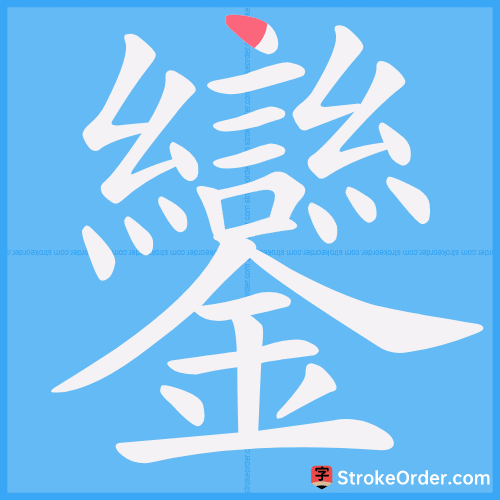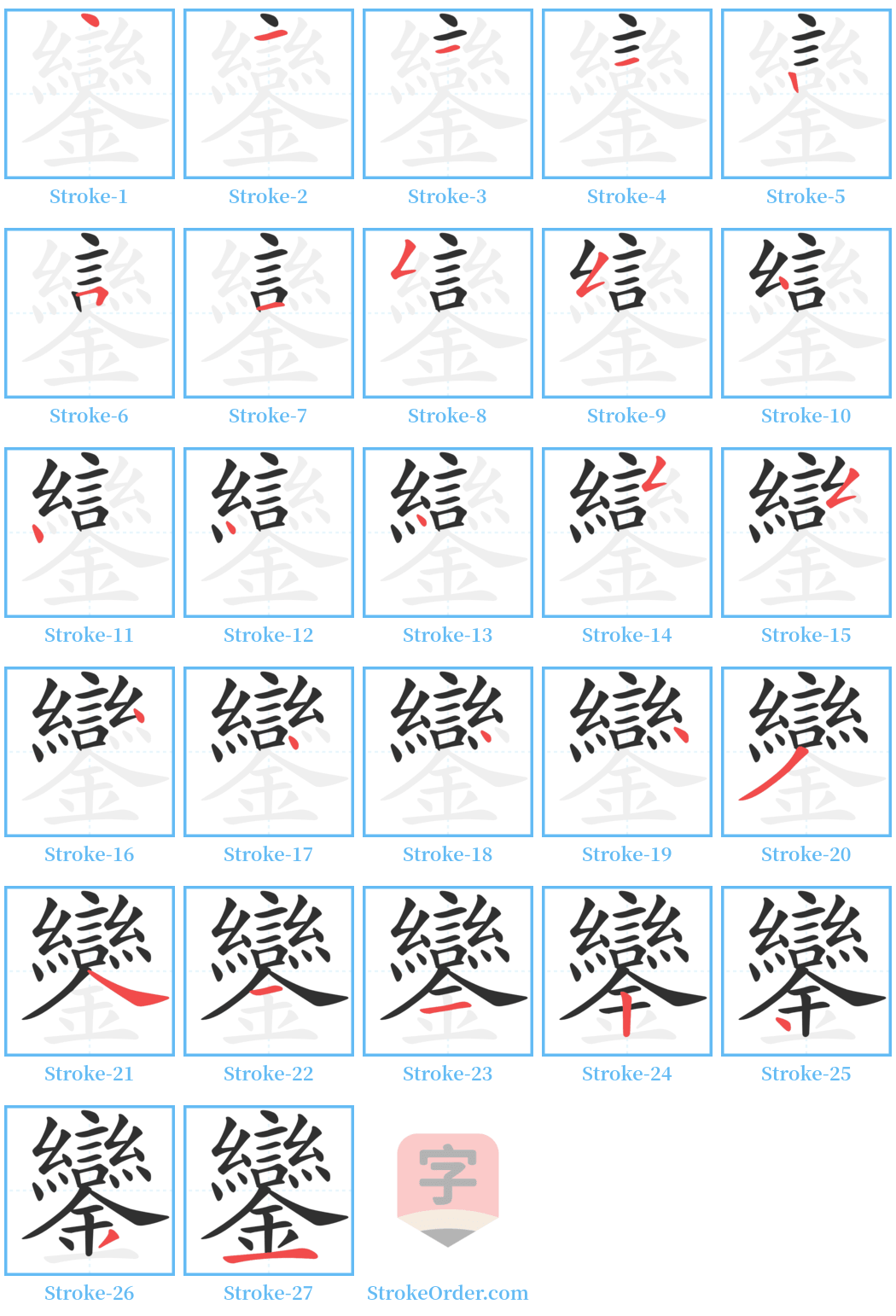鑾 Stroke Order
Animated Stroke Order of 鑾

Stroke Order Diagrams for 鑾

Step-by-Step Handwriting Guide for 鑾

Learn to Write Chinese Characters with Video Tutorials
Watch the video of writing the Chinese character "鑾", learn the correct stroke order (笔顺) of the character "鑾", and master the standard way of writing the character "鑾".
Free Printable Handwriting Practice with Stroke Order: 鑾
Printable Writing Practice Worksheet of "鑾" in Portrait Orientation (Tian Zi Ge)

Printable Writing Practice Worksheet of "鑾" in Landscape Orientation (Tian Zi Ge)

Information of 鑾
Pinyin
luán
Radical
金
Strokes
27 strokes
Usage
★★★
Definition
imperial
鑾
luán
名
1. 一種鈴鐺: a type of bell: 鑾鈴 (luán lǐng).
2. 古代帝王的車駕上有鑾鈴,故亦作帝王車駕的代稱: used in ancient emperors' carriages, hence also a term for the imperial carriage: 鑾儀 (luán yí - the emperor's carriage and procession), 鑾駕 (luán jià - imperial carriage), 鑾輿 (luán yú - imperial palanquin), 隨鑾 (suí luán - to accompany the imperial carriage), 迎鑾 (yíng luán - to welcome the imperial carriage).
【本义】: 古時皇帝車駕所用的鈴: The original meaning refers to the bells used in the carriages of emperors in ancient times.
【造字法】: 形聲。从金,羉( luán )聲: The character formation is phonetic; it consists of gold (金) and the phonetic element (羉, luán).
1. 古代皇帝車的儀鈴,安裝在軛首或車衡上方。上部一般為扁圓形的鈴,鈴內有彈丸,鈴上有輻射狀的鏤孔。下部為長方形的座;座的兩面常有釘孔。西周時開始流行 ([En.] bell): The ceremonial bell used on ancient emperors' vehicles, installed above the yoke or carriage balance. The upper part is generally a flattened round bell, containing pellets inside and with radiating holes on it. The lower part is a rectangular base, which often has nail holes on both sides, and it started becoming popular in the Western Zhou period.
2. 皇帝的車駕,因用作帝王的代稱 ([En.] imperial carriage): The emperor's carriage, also used as a term for imperial authority.
3. 另見 luǎn: See also luǎn.
【引】
1. 《說文》:人君乘車四馬四鑣八鑾,鈴象鸞,鳥聲,和則敬也: In the "Shuowen," it says: "When the sovereign rides in the carriage drawn by four horses, with eight bells, the sound resembles that of the luan bird, signifying respect."
2. 《禮記·經解》:升車則有鑾和之音: In the "Book of Rites," it says: "When ascending the carriage, there is the harmonious sound of the bells."
3. 《東京賦》:鑾聲噦噦: In "Tokyo Fu," it refers to the ringing sound of the bells.
【例】
如: 鑾刀 (a knife equipped with a ringing bell); 鑾輅 (a carriage adorned with bells); 鑾音 (the sound of bells); 鑾聲 (bell sound).
2. 皇帝的車駕,因用作帝王的代稱 ([En.] imperial carriage): The emperor's carriage, also used as a term for imperial authority.
【例】
如: 鑾回 (the imperial carriage turns around); 鑾駕 (the emperor's carriage, also refers to the emperor), 鑾駕隊子 (referring to close attendants of the emperor), 鑾駕提爐 (the ceremonial dignitaries during the emperor's or empress's funeral).
3. 另見 luǎn: See also luǎn.